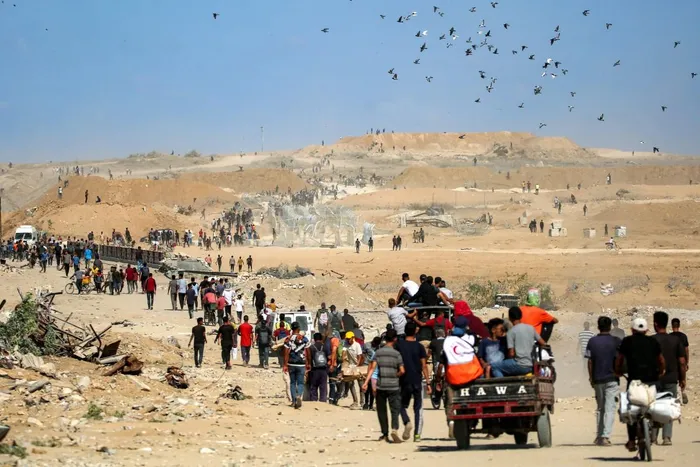Ceasefire brings hope: Palestinian families begin returning to northern Gaza City

Gaza's civil defence agency said on October 10 that Israeli forces have begun pulling back from parts of the territory, particularly in Gaza City and Khan Yunis.
Image: Eyad Baba/ AFP
In the first time in two years of war and onslaught, thousands of Palestinian families have begun returning to their homes in northern Gaza City.
This comes after the first phase of the ceasefire deal went into effect at 9am GMT.
Despite the ceasefire deal, the Israeli army said it had “positioned itself in the latest deployment lines, in accordance with the outline of the ceasefire agreement”. The Israeli forces in the Southern Command said it is deployed in the area and will continue to operate to "eliminate any immediate threat.”
Attacks continued until the ceasefire went into effect as reports emerged that Israel launched a deadly attack from helicopters on a site east of Gaza City and conducted air attacks in the southern Khan Younis area.
'We are returning home'
Gaza’s civil defence warned people to keep away from the border areas of Gaza City until the official announcement of the withdrawal of Israeli forces.
Gaza’s police force said officers would “fulfil their duties of serving and supporting citizens, and protecting public and private property”. They also urged people to be “extremely cautious” and to look out for “suspicious objects, hazardous waste, and unexploded bombs” when returning to their homes.
Israel warned certain areas were still off-limits and that Palestinians should steer clear of its forces while they were "adjusting operational positions in the Gaza Strip".
Amjad Shawa, head of the Palestinian NGOs Network, told Al Jazeera that Palestinians were “exercising their right to return”.
Residents of several areas of the Gaza Strip also told AFP the Israeli military appeared to have withdrawn from positions it held on Thursday.
"I'm happy about the truce and peace, even though I'm a mother of a son and a daughter who were killed and I grieve for them deeply. Yet, the truce also brings joy: returning to our homes," resident Areej Abu Saadaeh said.
"We're going back to our areas, full of wounds and sorrow, but we thank God for this situation," 32-year-old Ameer Abu Iyadeh told AFP in Khan Yunis.
How many Palestinians were displaced?
United Nations Office for the Coordination of Humanitarian Affairs (OCHA) reported that over 82% of the Gaza Strip remains within the Israeli-militarised zone, under displacement orders, or where these overlap, as of October 1 2025.
Since March 18 this year when the ceasefire collapsed, over 1.2 million people have been reported displaced across the Gaza Strip, SMC reported.
By the end of September, over 60,000 forcibly displaced persons were estimated to be living in UNRWA shelters and the surrounding areas, with UNRWA running around 59 shelters.
At the time of publication, 11 UNRWA shelters were hosting nearly 2,000 families in Gaza City. At least 197 UNRWA installations – or over half of all UNRWA installations in the Gaza Strip – are located within the Israeli-militarised zone, under displacement orders, or where these overlap.
IOL